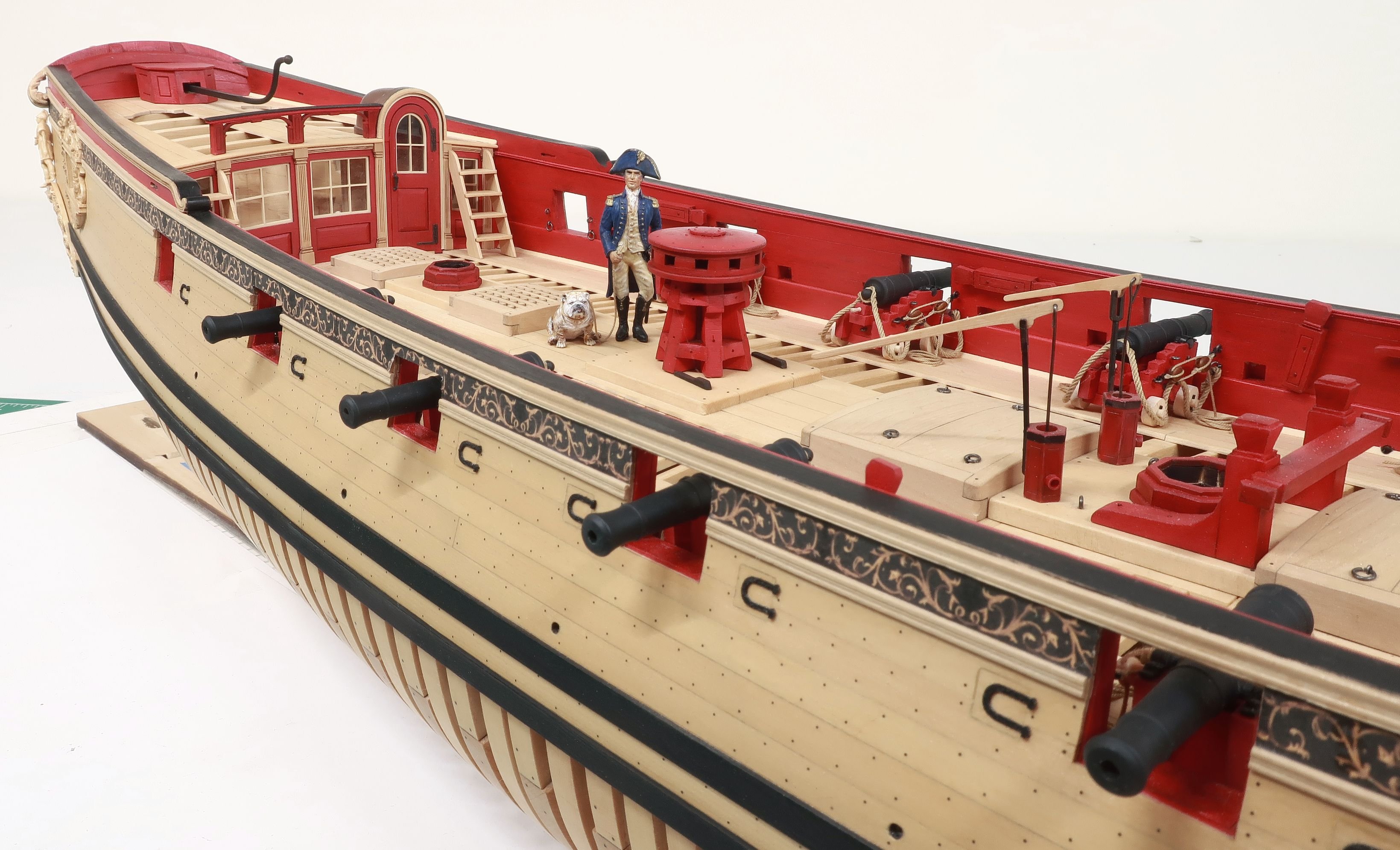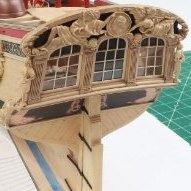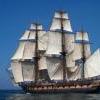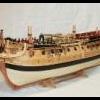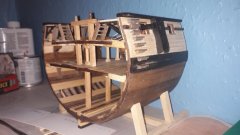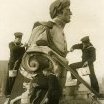MORE HANDBOOKS ARE ON THEIR WAY! We will let you know when they get here.
×
-
Posts
9,532 -
Joined
-
Last visited
Reputation Activity
-
 Chuck got a reaction from Kusawa2000 in Boat/barge for the Winnie
Chuck got a reaction from Kusawa2000 in Boat/barge for the Winnie
The pinnace or barge for the winnie will be a project unto itself. A true mini kit. It will be fairly large with plenty of detail. It will be stored on spare topmasts in the waist like this contemporary model. Only one boat as I dont want them to completely take attention away from the other parts of the model. With more boats your eye tends to focus and stay right there.....
Having one super detailed barge will really add to the model. It will be around 8" long give or take. The plan and draft for this complex mini-kit is already underway!!!!
-
 Chuck got a reaction from FrankWouts in HMS Winchelsea - FINISHED - 1764 - by Chuck (1/4" scale)
Chuck got a reaction from FrankWouts in HMS Winchelsea - FINISHED - 1764 - by Chuck (1/4" scale)
I have completed all of the partners and coamings......I can almost start planking the deck now. I forgot one last detail which I will show you guys soon. But here are some pics.
The foremast partners are made from laser cut parts and then I added the bolts. I used 15 pound filament for those. Use a #75 drill bit for the holes.
You can also see the base plate for the stove. You have a few options with this. I have laser cut a nice base for you. At this time the base was most likely just a large iron plate....but in some cases they used flagstone or slate. If you want to depict the iron plate....just flip it over and paint it matte black. But if you want to show some slate or flagstones, I have laser etched the other side with a stone tile pattern.
Simply paint it matte black first but keep the coaming natural. Then use some weathering powders on the tiles to make them only slightly lighter. Leave the etched grout lines (which are deeper) dark black. But use some grays and rust colors to make a subtle stone base. Dont over do it!!!
The main mast partners were done the same as the fore mast partners. None of these are glued in position yet but I will be doing so soon!!!
Any comments or questions!!!!!!!
-
 Chuck got a reaction from Murphy in HMS Winchelsea - FINISHED - 1764 - by Chuck (1/4" scale)
Chuck got a reaction from Murphy in HMS Winchelsea - FINISHED - 1764 - by Chuck (1/4" scale)
I have completed all of the partners and coamings......I can almost start planking the deck now. I forgot one last detail which I will show you guys soon. But here are some pics.
The foremast partners are made from laser cut parts and then I added the bolts. I used 15 pound filament for those. Use a #75 drill bit for the holes.
You can also see the base plate for the stove. You have a few options with this. I have laser cut a nice base for you. At this time the base was most likely just a large iron plate....but in some cases they used flagstone or slate. If you want to depict the iron plate....just flip it over and paint it matte black. But if you want to show some slate or flagstones, I have laser etched the other side with a stone tile pattern.
Simply paint it matte black first but keep the coaming natural. Then use some weathering powders on the tiles to make them only slightly lighter. Leave the etched grout lines (which are deeper) dark black. But use some grays and rust colors to make a subtle stone base. Dont over do it!!!
The main mast partners were done the same as the fore mast partners. None of these are glued in position yet but I will be doing so soon!!!
Any comments or questions!!!!!!!
-
 Chuck got a reaction from OldChur in HMS Winchelsea - FINISHED - 1764 - by Chuck (1/4" scale)
Chuck got a reaction from OldChur in HMS Winchelsea - FINISHED - 1764 - by Chuck (1/4" scale)
I have completed all of the partners and coamings......I can almost start planking the deck now. I forgot one last detail which I will show you guys soon. But here are some pics.
The foremast partners are made from laser cut parts and then I added the bolts. I used 15 pound filament for those. Use a #75 drill bit for the holes.
You can also see the base plate for the stove. You have a few options with this. I have laser cut a nice base for you. At this time the base was most likely just a large iron plate....but in some cases they used flagstone or slate. If you want to depict the iron plate....just flip it over and paint it matte black. But if you want to show some slate or flagstones, I have laser etched the other side with a stone tile pattern.
Simply paint it matte black first but keep the coaming natural. Then use some weathering powders on the tiles to make them only slightly lighter. Leave the etched grout lines (which are deeper) dark black. But use some grays and rust colors to make a subtle stone base. Dont over do it!!!
The main mast partners were done the same as the fore mast partners. None of these are glued in position yet but I will be doing so soon!!!
Any comments or questions!!!!!!!
-
 Chuck got a reaction from FrankWouts in HMS Winchelsea - FINISHED - 1764 - by Chuck (1/4" scale)
Chuck got a reaction from FrankWouts in HMS Winchelsea - FINISHED - 1764 - by Chuck (1/4" scale)
Back to the Winnie....
To make the gratings for the gun deck you will need 3 packages of my cambered grating mini kits. I will not be including these in the package for chapter 4 because I sell them in either cedar (less expensive) or boxwood. Both would work and you guys can choose. You will also need the grating jig. One jig should last you the entire project.
To start, figure out how many cambered laser cut grating strips you will need to fit the space in your coaming. Only build what you need. For example this grating below on left side needed just seven grating strips in the jig. My coaming were designed so each grating will fit perfectly when finished. So dont use more than the space needs.
Then use the supplied strips and press them into the notches carefully. You will notice they will probably be too tight at first. This is by design. You need to run some sandpaper down the strip until it becomes a nice press-fit into the notches. Once again only use the number of strips you need. In this case 13 strips pressed firmly in position...
At this stage you should look it over to make sure no grating strips went crooked while you were fitting the batten strips. If they did your holes wont be equal in shape and size. Fix those now using a toothpick if they lean over. Its easy to do.
Then paint on some watered down tite-bond. Get it in all the nooks and crannies. Not too thick. If the holes start clogging....add more water.
Wait about 2 minutes but not so long that the glue will dry. You want to carefully pry the grating free of the jig before it dries and is glued to the jig!!!
Then clean up the jig for the next grating. But you are not done yet. Brush more glue on the bottom underside of the grating. Set it aside to dry fully.
Now you are probably saying.... how in world will these ugly dirty gratings look good. Right now they look awful.
Snip off the excess from the perimeter and file the sides smooth. Check the fit in the coaming. Then start sanding the top surface. In the center photo below you can see I have sanding that grating only on one side. The finished grating can be seen coming to light.
The one on the right is completed. These are cedar gratings by the way. Now should you sand the bottom too? You dont have to.....BUT, I am sure you have seen those contemporary models and have seen how thin they are. I wouldnt recommend going too thin. But it does change the way the grating looks in the coaming.
And here are the finished coamings with the gratings in position.
ANY QUESTIONS????
-
 Chuck got a reaction from Mike Y in HMS Winchelsea - FINISHED - 1764 - by Chuck (1/4" scale)
Chuck got a reaction from Mike Y in HMS Winchelsea - FINISHED - 1764 - by Chuck (1/4" scale)
Back to the Winnie....
To make the gratings for the gun deck you will need 3 packages of my cambered grating mini kits. I will not be including these in the package for chapter 4 because I sell them in either cedar (less expensive) or boxwood. Both would work and you guys can choose. You will also need the grating jig. One jig should last you the entire project.
To start, figure out how many cambered laser cut grating strips you will need to fit the space in your coaming. Only build what you need. For example this grating below on left side needed just seven grating strips in the jig. My coaming were designed so each grating will fit perfectly when finished. So dont use more than the space needs.
Then use the supplied strips and press them into the notches carefully. You will notice they will probably be too tight at first. This is by design. You need to run some sandpaper down the strip until it becomes a nice press-fit into the notches. Once again only use the number of strips you need. In this case 13 strips pressed firmly in position...
At this stage you should look it over to make sure no grating strips went crooked while you were fitting the batten strips. If they did your holes wont be equal in shape and size. Fix those now using a toothpick if they lean over. Its easy to do.
Then paint on some watered down tite-bond. Get it in all the nooks and crannies. Not too thick. If the holes start clogging....add more water.
Wait about 2 minutes but not so long that the glue will dry. You want to carefully pry the grating free of the jig before it dries and is glued to the jig!!!
Then clean up the jig for the next grating. But you are not done yet. Brush more glue on the bottom underside of the grating. Set it aside to dry fully.
Now you are probably saying.... how in world will these ugly dirty gratings look good. Right now they look awful.
Snip off the excess from the perimeter and file the sides smooth. Check the fit in the coaming. Then start sanding the top surface. In the center photo below you can see I have sanding that grating only on one side. The finished grating can be seen coming to light.
The one on the right is completed. These are cedar gratings by the way. Now should you sand the bottom too? You dont have to.....BUT, I am sure you have seen those contemporary models and have seen how thin they are. I wouldnt recommend going too thin. But it does change the way the grating looks in the coaming.
And here are the finished coamings with the gratings in position.
ANY QUESTIONS????
-
 Chuck got a reaction from Murphy in HMS Winchelsea - FINISHED - 1764 - by Chuck (1/4" scale)
Chuck got a reaction from Murphy in HMS Winchelsea - FINISHED - 1764 - by Chuck (1/4" scale)
Back to the Winnie....
To make the gratings for the gun deck you will need 3 packages of my cambered grating mini kits. I will not be including these in the package for chapter 4 because I sell them in either cedar (less expensive) or boxwood. Both would work and you guys can choose. You will also need the grating jig. One jig should last you the entire project.
To start, figure out how many cambered laser cut grating strips you will need to fit the space in your coaming. Only build what you need. For example this grating below on left side needed just seven grating strips in the jig. My coaming were designed so each grating will fit perfectly when finished. So dont use more than the space needs.
Then use the supplied strips and press them into the notches carefully. You will notice they will probably be too tight at first. This is by design. You need to run some sandpaper down the strip until it becomes a nice press-fit into the notches. Once again only use the number of strips you need. In this case 13 strips pressed firmly in position...
At this stage you should look it over to make sure no grating strips went crooked while you were fitting the batten strips. If they did your holes wont be equal in shape and size. Fix those now using a toothpick if they lean over. Its easy to do.
Then paint on some watered down tite-bond. Get it in all the nooks and crannies. Not too thick. If the holes start clogging....add more water.
Wait about 2 minutes but not so long that the glue will dry. You want to carefully pry the grating free of the jig before it dries and is glued to the jig!!!
Then clean up the jig for the next grating. But you are not done yet. Brush more glue on the bottom underside of the grating. Set it aside to dry fully.
Now you are probably saying.... how in world will these ugly dirty gratings look good. Right now they look awful.
Snip off the excess from the perimeter and file the sides smooth. Check the fit in the coaming. Then start sanding the top surface. In the center photo below you can see I have sanding that grating only on one side. The finished grating can be seen coming to light.
The one on the right is completed. These are cedar gratings by the way. Now should you sand the bottom too? You dont have to.....BUT, I am sure you have seen those contemporary models and have seen how thin they are. I wouldnt recommend going too thin. But it does change the way the grating looks in the coaming.
And here are the finished coamings with the gratings in position.
ANY QUESTIONS????
-
 Chuck got a reaction from FrankWouts in HMS Winchelsea - FINISHED - 1764 - by Chuck (1/4" scale)
Chuck got a reaction from FrankWouts in HMS Winchelsea - FINISHED - 1764 - by Chuck (1/4" scale)
Im just really bored with seeing so many Syren kits getting built. Since there is a huge lack of American ships on the market that are any good I figured I would rectify that situation. All you ever see are Syren and Constitution kits being built for the most part.....and the occasional Hahn colonial schooner. Time to diversify as there are so many to choose from.
-
 Chuck got a reaction from bdgiantman2 in HMS Winchelsea - FINISHED - 1764 - by Chuck (1/4" scale)
Chuck got a reaction from bdgiantman2 in HMS Winchelsea - FINISHED - 1764 - by Chuck (1/4" scale)
Im just really bored with seeing so many Syren kits getting built. Since there is a huge lack of American ships on the market that are any good I figured I would rectify that situation. All you ever see are Syren and Constitution kits being built for the most part.....and the occasional Hahn colonial schooner. Time to diversify as there are so many to choose from.
-
 Chuck got a reaction from Murphy in HMS Winchelsea - FINISHED - 1764 - by Chuck (1/4" scale)
Chuck got a reaction from Murphy in HMS Winchelsea - FINISHED - 1764 - by Chuck (1/4" scale)
Im just really bored with seeing so many Syren kits getting built. Since there is a huge lack of American ships on the market that are any good I figured I would rectify that situation. All you ever see are Syren and Constitution kits being built for the most part.....and the occasional Hahn colonial schooner. Time to diversify as there are so many to choose from.
-
 Chuck reacted to English Rebel in HM Cutter Cheerful 1806 by Chuck - FINISHED - 1:48 scale - kit prototype
Chuck reacted to English Rebel in HM Cutter Cheerful 1806 by Chuck - FINISHED - 1:48 scale - kit prototype
Chuck
Just read this build. Your model-making talents are amazing, as is your incredible attention to detail. Well done.
Alan
-
 Chuck got a reaction from Nunnehi (Don) in HM Cutter Cheerful 1806 by Chuck - FINISHED - 1:48 scale - kit prototype
Chuck got a reaction from Nunnehi (Don) in HM Cutter Cheerful 1806 by Chuck - FINISHED - 1:48 scale - kit prototype
Thank You for the kind words.
Here are some of the details for those folks that are building Cheerful too.
To finish the half of the sling that is on the yard, I served a length of .035 dark brown rope. Then I seized a thimble into one end. I only made a few wraps of the thread when I seized it and then snipped off the loose end so it sticks out just a tiny bit as shown below.
The longer end was cut so the entire span was 2 3/4" long. Then the long end was brought up to the thimble and glued into position. The seam is hardly visible after it was glued. The two ends were carefully butt against each other as well as the edges glue to each other. Then I waited for it to dry thoroughly. You can use Yellow glue for this but use is straight because if you dilute it the joint wont be very strong....I suppose CA would work but I know that is frowned upon.
Once dry, I served the remaining area below the thimble so it strengthened the joint. Then I carried the serving around the between the thimble and the split area as shown...just two wraps more as this also holds that splice joint together. Then a thinned wash of yellow glue was brush all over the siezing and allowed to dry. It was quite strong and did the trick nicely.
You can see this portion of the sling placed on the lower yard. The same thing is done for the sling on the topsail yard but this time .025 dark brown rope was used. and the length was much shorter.
This is an image of the lower yard fully set up with stirrups and horses. The brace pendants were set up for the fore and aft braces and the clue line blocks hung from the center of the yard. I used .025 dark brown rope for the stirrups and horses. The stirrups were wrapped three times around the yard and then the end with the eye in hung down the aft side. It was 11/16" below the yard and a simple eye seized on its end so I could run the horse through it. The stirrups also hang on the outside of the yard as opposed to the inside of the three wraps. Hope that makes sense. Also attached is a PDF of the yards and all the rigging as it differs a bit from the earlier plans that we made. All new plans have been updated to show this layout. The yards were a bit too long on my original drafting for the project. I have shortened them up based on some research but the diameter of each yard stays the same as it was noted originally.
yards for cheerful.pdf
And the completed topsail yard
-
 Chuck got a reaction from Rustyj in HMS Winchelsea - FINISHED - 1764 - by Chuck (1/4" scale)
Chuck got a reaction from Rustyj in HMS Winchelsea - FINISHED - 1764 - by Chuck (1/4" scale)
Im just really bored with seeing so many Syren kits getting built. Since there is a huge lack of American ships on the market that are any good I figured I would rectify that situation. All you ever see are Syren and Constitution kits being built for the most part.....and the occasional Hahn colonial schooner. Time to diversify as there are so many to choose from.
-
 Chuck got a reaction from FrankWouts in HMS Winchelsea - FINISHED - 1764 - by Chuck (1/4" scale)
Chuck got a reaction from FrankWouts in HMS Winchelsea - FINISHED - 1764 - by Chuck (1/4" scale)
Leopard!!!! No thats not gonna be a choice. Its going to be a long while before I tackle a project as large and complex as the Winnie again. I am going to do a few smaller subjects after this one guys. The number of laser cut parts and designed elements is about four times more than you will find in most or all kits of this size. Thats a lot of parts!!! I want to simplify after this one is done.
And I still have to produce a POF cross section for Winnie!!!! I just want to see if I can tackle the design challenge to give you something new with the cross section. I think it could be a nice extension of the group project as well.
Chuck
-
 Chuck got a reaction from FrankWouts in HMS Winchelsea - FINISHED - 1764 - by Chuck (1/4" scale)
Chuck got a reaction from FrankWouts in HMS Winchelsea - FINISHED - 1764 - by Chuck (1/4" scale)
Thank You fellas
Today I added the waterway on top of the margin planks. Originally I was going to use a 1/16" x 1/16" strip. But after some thought I switched and used a 3/64" x 3/64" strip of cedar. I carefully sanded away one corner so the strip was like a quarter round molding. Then I glued it along the bulwarks.
Then it was time for the checker pattern floor in the great cabin. This is 3/64" thick. It is laser etched with the pattern as you can see. It is cut over-sized so with a little tweaking it should fit everyone's model. So it is crucial that you make a paper pattern first that fits in the space tight. Then trace it on the sheet and cut it to fit your model. Try for a nice tight fit!!! I prefer a subtle pattern that isnt too dark. So many models end up with a black and white pattern which I find so distracting.
Remember where the forward bulkhead will be so you position the forward edge correctly. My floor ends right under where the deck beam will be so I know the bulkhead will sit on top of the edge of the checker pattern.
From this point, I will slowly make my way forward building the various coamings and partners. This needs to be done so we can plank the deck properly around these items. You can see that the one coaming and grating was completed. I wont add the ladder until later. But I did manage to build the capstan partners.
The capstan partner sits against the coaming. It is also laser cut in three pieces and glues together quickly. I simulated the seams between each section. I also softened the top edge because it shouldnt be a hard edge.
One interesting feature about the partners is that it should NOT be glued directly to the false deck. The deck is sloped which is to be expected. But the partners need to be level otherwise the capstan will not work properly. This means the forward edge of the partners need to be lifted a bit to raise it up and level it off. I did this with a little cheat. I added a small length of a 1/32" strip under the forward edge which will be covered up after we plank the deck. You will notice how it looks lifted up on the forward side and level. If you need to sand the bottom of the aft edge a bit to make it level then that is OK also.
I simulated the bolts using 20 pound black monfilament. You guys should pick some up in various sizes as we will be using it a lot throught the model.
Chuck
-
 Chuck got a reaction from FrankWouts in HMS Winchelsea - FINISHED - 1764 - by Chuck (1/4" scale)
Chuck got a reaction from FrankWouts in HMS Winchelsea - FINISHED - 1764 - by Chuck (1/4" scale)
Today I planked the inboard stern. There are five strakes. They are all laser cut with the proper curve. Note that I started with the top plank so it would be flush with the bottoms of the windows. We will be adding a thin sill and some molding later on top of this to finish it off. Excuse the dust!!! But each new addition does clean every up a bit and make it look nicer covering up all of the frames and bulkheads. I also decided NOT to high light the seams between these planks as I think they would look too busy. It will look cleaner this way with the paneled rudder trunk and benches in front of it.
Also not how the bottom three planks dont span the entire width of the stern. The center will be left open for the rudder and this whole area will be covered with the paneled rudder trunk. In fact we will be adding the rudder real soon.
But first I want to get the deck planked. So next up was adding the margin planks. These are also laser cut with scarfs. But be aware that it is unlikely that these will fit your model perfectly. There will be so many differences in the way each of you fair inboard and create the inboard shape of the hull. So some of you will no doubt have to use them as a starting point to trace them and cut new ones to fit your model. Its not very hard to do. They are 3/64" thick. The aft section against the transom was positioned first. The aft edge was beveled to fit snug against the transom.
Then I started adding each of the four sections along each side. Starting at the bow and working my way aft.
Next up I will add the waterway which will be a 1/16" x 1/16" strip that is angled on the inboard side. You know the drill. Its the same way as done with all of my projects. Once that is done I will start building the platforms and coaming down the center of the deck so I can plank around them. Here is how she looks now. Testing the deck beams too!!!
-
 Chuck got a reaction from FrankWouts in HMS Winchelsea - FINISHED - 1764 - by Chuck (1/4" scale)
Chuck got a reaction from FrankWouts in HMS Winchelsea - FINISHED - 1764 - by Chuck (1/4" scale)
ship rigged Hornet...built to the lines of Wasp as she appeared in 1812. I believe 10 ports per side.
-
 Chuck got a reaction from FrankWouts in HMS Winchelsea - FINISHED - 1764 - by Chuck (1/4" scale)
Chuck got a reaction from FrankWouts in HMS Winchelsea - FINISHED - 1764 - by Chuck (1/4" scale)
Thats the only reason why I personally want to do this POF cross section. Its fun for me to solve those design issues. In fact....since those pics were taken I have simplified and changes the frame design slightly. The improved versions are even easier to build and assemble.
Chuck
-
 Chuck got a reaction from Edwardkenway in HMS Winchelsea - FINISHED - 1764 - by Chuck (1/4" scale)
Chuck got a reaction from Edwardkenway in HMS Winchelsea - FINISHED - 1764 - by Chuck (1/4" scale)
Thats the only reason why I personally want to do this POF cross section. Its fun for me to solve those design issues. In fact....since those pics were taken I have simplified and changes the frame design slightly. The improved versions are even easier to build and assemble.
Chuck
-
 Chuck got a reaction from Jorge Diaz O in HMS Winchelsea - FINISHED - 1764 - by Chuck (1/4" scale)
Chuck got a reaction from Jorge Diaz O in HMS Winchelsea - FINISHED - 1764 - by Chuck (1/4" scale)
Im just really bored with seeing so many Syren kits getting built. Since there is a huge lack of American ships on the market that are any good I figured I would rectify that situation. All you ever see are Syren and Constitution kits being built for the most part.....and the occasional Hahn colonial schooner. Time to diversify as there are so many to choose from.
-
 Chuck got a reaction from VTHokiEE in HMS Winchelsea - FINISHED - 1764 - by Chuck (1/4" scale)
Chuck got a reaction from VTHokiEE in HMS Winchelsea - FINISHED - 1764 - by Chuck (1/4" scale)
Im just really bored with seeing so many Syren kits getting built. Since there is a huge lack of American ships on the market that are any good I figured I would rectify that situation. All you ever see are Syren and Constitution kits being built for the most part.....and the occasional Hahn colonial schooner. Time to diversify as there are so many to choose from.
-
 Chuck got a reaction from Murphy in HMS Winchelsea - FINISHED - 1764 - by Chuck (1/4" scale)
Chuck got a reaction from Murphy in HMS Winchelsea - FINISHED - 1764 - by Chuck (1/4" scale)
ship rigged Hornet...built to the lines of Wasp as she appeared in 1812. I believe 10 ports per side.
-
 Chuck got a reaction from Ronald-V in HMS Winchelsea - FINISHED - 1764 - by Chuck (1/4" scale)
Chuck got a reaction from Ronald-V in HMS Winchelsea - FINISHED - 1764 - by Chuck (1/4" scale)
Leopard!!!! No thats not gonna be a choice. Its going to be a long while before I tackle a project as large and complex as the Winnie again. I am going to do a few smaller subjects after this one guys. The number of laser cut parts and designed elements is about four times more than you will find in most or all kits of this size. Thats a lot of parts!!! I want to simplify after this one is done.
And I still have to produce a POF cross section for Winnie!!!! I just want to see if I can tackle the design challenge to give you something new with the cross section. I think it could be a nice extension of the group project as well.
Chuck
-
 Chuck got a reaction from Stuntflyer in HMS Winchelsea - FINISHED - 1764 - by Chuck (1/4" scale)
Chuck got a reaction from Stuntflyer in HMS Winchelsea - FINISHED - 1764 - by Chuck (1/4" scale)
Thats the only reason why I personally want to do this POF cross section. Its fun for me to solve those design issues. In fact....since those pics were taken I have simplified and changes the frame design slightly. The improved versions are even easier to build and assemble.
Chuck
-
 Chuck got a reaction from Ryland Craze in HMS Winchelsea - FINISHED - 1764 - by Chuck (1/4" scale)
Chuck got a reaction from Ryland Craze in HMS Winchelsea - FINISHED - 1764 - by Chuck (1/4" scale)
Thats the only reason why I personally want to do this POF cross section. Its fun for me to solve those design issues. In fact....since those pics were taken I have simplified and changes the frame design slightly. The improved versions are even easier to build and assemble.
Chuck

